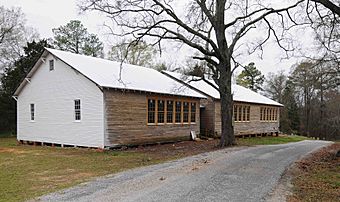Howard Junior High School facts for kids
Quick facts for kids |
|
|
Howard Junior High School
|
|

Howard Junior High School, March 2012
|
|
| Location | 431 Shiloh St., Prosperity, South Carolina |
|---|---|
| Area | 2.7 acres (1.1 ha) |
| Built | 1925 |
| Architectural style | Late 19th And Early 20th Century American Movements |
| NRHP reference No. | 05001577 |
| Added to NRHP | February 3, 2006 |
Howard Junior High School is a special historic building in Prosperity, South Carolina. It was once a school known by several names, including Prosperity School and Shiloh Rosenwald School. This school played an important role in education for African American children during a time when schools were separated.
Contents
Howard Junior High School: A Historic Place
Howard Junior High School was built between 1924 and 1925. It is a great example of a Rosenwald school. These schools were built across the Southern United States for African American children. They were created with help from Julius Rosenwald, who was the head of Sears, Roebuck and Company.
What Was a Rosenwald School?
During the early 1900s, many schools for African American children in the South were not very good. Julius Rosenwald worked with Booker T. Washington and the Tuskegee Institute to change this. They created a program to build better schools. These schools were often simple but well-designed buildings. They provided a much better learning environment for thousands of students.
The School Building and Its History
Howard Junior High School is a one-story building made of wood. It has a rectangular shape. When it was first built, it had four classrooms. This was a big step forward for education in the area. Later, in the 1930s, two more classrooms were added. This allowed even more students to attend and learn. The school sits on a foundation of brick piers.
Becoming a National Historic Site
Because of its important history, Howard Junior High School was added to the National Register of Historic Places in 2009. This is a list of places in the United States that are important to history. Being on this list helps protect the building. It also helps people remember its story and the role it played in education.



